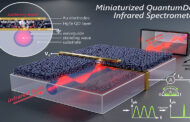
Reinforcement of an intermediate slab with memory-steel.
A new building material developed at Empa is about to be launched on the market: “memory-steel” can not only be used to reinforce new, but also existing concrete structures.
When the material is heated (one-time), prestressing occurs automatically. The Empa spin-off re-fer AG is now presenting the material with shape memory in a series of lectures.
So far, the steel reinforcements in concrete structures are mostly prestressed hydraulically. This requires ducts for guiding the tension cables, anchors for force transfer and oil-filled hydraulic jacks. The space requirements of all these apparatuses created the geometric framework conditions for every prestressed concrete structure; the strengthening of older structures therefore sometimes fails due to the high space requirements of this proven method.
In around 15 years of research work, experts from Empa and re-fer AG have now brought an alternative method to series production readiness: shape memory alloys based on iron, which contract during heating and thus permanently prestress the concrete structure. Hydraulic prestressing can thus be avoided – it is sufficient to heat the steel shortly, for example by means of electric current or infrared radiators. The new building material will be marketed immediately under the name “memory-steel”. Several pilot projects, such as the reinforcement of various reinforced concrete slabs, have already been successful.
Development of memory-steel
The development of memory-steel began in the early 2000s. In the previous decades, Empa had already pioneered the strengthening of concrete with carbon fibre reinforced polymers (CFRP). This led to the idea of using shape memory alloys for prestressing concrete. Initial tests with nickel-titanium alloys were positive. However, the material known from medicine is far too expensive for use in the construction sector. In 2009, Empa researchers succeeded in developing an iron-based shape memory alloy, which they also patented. In 2012, researchers around Julien Michels finally founded the company re-fer AG; Michels has been CEO of the young company ever since.

Memory-steel reinforcement bars
New opportunities for old buildings
Memory-steel should first of all be used for the strengthening of existing buildings. As soon as, for example, new windows, doors or lift shafts are installed in the concrete structure of an old building, a new reinforcement of the load-bearing structure is often unavoidable. In industrial buildings, the load-bearing capacity of an old suspended slab sometimes has to be increased. Thanks to memory-steel, such tasks can now also be easily solved in confined spaces: Either a strip of special steel is fastened under the ceiling using dowels and then heated with electricity or an infrared radiator. Alternatively, the reinforcement can also be set in concrete: First a groove is milled into the surface of the concrete slab, then a ribbed reinforcement bar made of memory-steel is inserted into the groove and filled with special mortar. Finally, the profile is heated with the aid of direct current and thus prestressed. Another variant is to embed the reinforcement bar in an additional shotcrete layer.
Precast concrete elements with special geometry
In the future, memory-steel could also be a proven method for manufacturing precast concrete parts with a previously unknown geometry. The hydraulic prestressing used up to now creates friction in curved structures, which greatly limits the use of this method. With a memory-steel profile embedded in concrete, highly curved constructions are now also possible: when heated, the profile contracts uniformly over its entire length without friction losses and transfers the stress to the concrete.
Market launch of memory-steel
The ready-to-install memory-steel profiles are manufactured by Voestalpine Böhler Edelstahl GmbH & Co KG in Austria. The company is also working with re-fer and Empa to further develop the composition of the alloy.
The new building material memory-steel will be presented to interested building experts and architects during four technical seminars. Contact persons include experts from re-fer, Empa researchers, concrete experts from Sika AG and concrete profile manufacturer Stahlton AG.
The Latest on: Memory-steel
[google_news title=”” keyword=”memory-steel” num_posts=”10″ blurb_length=”0″ show_thumb=”left”]
via Google News
The Latest on: Memory-steel
- Loom & Leaf Mattress Review: A Firm and Fancy All-Foam Bedon April 26, 2024 at 2:00 pm
Saatva's Loom & Leaf is a high-end memory foam mattress with multiple firmness options that are perfect for stomach and back sleepers.
- 'Pain and suffering': Bay Area town fights club over display in public parkon April 25, 2024 at 11:29 pm
A towering steel cross that once sat on Albany Hill, the eucalyptus-laden mound off Interstate 80 that’s adorned with high-rise condos looking out over the bay, is at the center of a legal battle ...
- Poetry reading series to honor memory of Richard Foxon April 25, 2024 at 2:21 am
Funding donations from family and friends of Richard Fox will allow for poetry events in his memory, including a poetry reading series.
- Best DDR4 RAM For Gamingon April 24, 2024 at 11:00 am
The Patriot Viper Steel RGB DDR4 lights up your gaming setup with vibrant, customizable RGB effects. This high-capacity (64GB) kit also offers decent performance for mainstream gaming and everyday use ...
- 6 Affordable Mattresses in 2024on April 23, 2024 at 5:00 pm
However, memory foam mattresses can be quite affordable as well and may give you more comfort than the traditional steel coils and foam of innerspring mattresses. If you need to be more budget ...
- Vidya Balan Celebrates "Stainless Steel" and Tambram Culture with this new Reelon April 23, 2024 at 10:01 am
MUMBAI: Following the success of "Do Aur Do Pyaar," which features a hilarious running gag about stainless steel, Vidya Balan has posted another funny reel, much to the delight of her fans. The reel, ...
- Bear Natural Mattress Review 2024: The Latest Newcomer to the Bear Lineupon April 23, 2024 at 7:01 am
Interested in learning more about Bear's newest natural offering? Here's what we like, what we don't and who it should work out best for at the end of the day.
- Prostate cancer fundraising drive held in memory of Corby steelworkeron April 23, 2024 at 6:47 am
Former steelworker Joe Campbell died last year and his two sons decided to do something to raise cash for Prostate Cancer UK in his memory. Mechanical engineering team leader David and crane resource ...
- Schumer says US will provide $6.1 billion to Micron Technology for chip plants in NY, Idahoon April 17, 2024 at 5:22 pm
The Biden administration has reached an agreement to provide $6.1 billion in government support for Micron Technology to produce advanced memory computer chips in New York and Idaho ...
via Bing News







